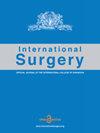Roux-en-Y Reconstruction Following Distal Gastrectomy Reduced Endoscopic Reflux Esophagitis in Older Adults: Propensity Score–Matching Analysis
IF 0.2
4区 医学
Q4 SURGERY
引用次数: 0
Abstract
This study aimed to examine the functional outcomes of Roux-en-Y (RY) and Billroth I (BI) reconstruction methods following distal gastrectomy in patients ages ≥75 years with gastric cancer. RY and BI reconstructions are commonly performed after distal gastrectomy. However, no study has compared the 2 procedures in older adults. We identified older patients who underwent RY (n = 103) or BI (n = 71) reconstruction following distal gastrectomy from 2011 to 2018 in our database. Patients in the RY and BI groups were matched by propensity scores, and each group included 62 patients. We compared short-term surgical outcomes and clinical findings at 1 year postoperatively. Additionally, risk factors for endoscopic reflux esophagitis following distal gastrectomy were evaluated. Reflux esophagitis, bile reflux, and remnant gastritis were significantly less frequent in RY reconstruction than in BI reconstruction. Moreover, both BI reconstruction and preoperative hiatus hernias were independent risk factors for postoperative endoscopic reflux esophagitis. Although the incidence of postoperative surgical complications following RY and BI was similar, RY was found to cause delayed gastric emptying more frequently than BI. RY reconstruction is a favorable procedure to prevent reflux esophagitis in older patients, particularly in those with hiatal hernia.远端胃切除术后Roux-en-Y重建减少老年人内窥镜反流性食管炎:倾向评分匹配分析
本研究旨在探讨年龄≥75岁胃癌患者远端胃切除术后Roux-en-Y (RY)和Billroth I (BI)重建方法的功能结局。RY和BI重建通常在远端胃切除术后进行。然而,没有研究比较这两种方法在老年人中的应用。我们在我们的数据库中确定了2011年至2018年远端胃切除术后接受RY (n = 103)或BI (n = 71)重建的老年患者。RY组和BI组的患者通过倾向评分进行匹配,每组包括62例患者。我们比较了术后1年的短期手术结果和临床表现。此外,评估远端胃切除术后内镜下反流性食管炎的危险因素。反流性食管炎、胆汁反流和残余胃炎在RY重建中的发生率明显低于BI重建。此外,BI重建和术前裂孔疝都是术后内镜下反流性食管炎的独立危险因素。虽然RY和BI术后手术并发症的发生率相似,但RY引起胃排空延迟的频率高于BI。RY重建是防止老年患者反流性食管炎的有利手术,特别是对于裂孔疝患者。
本文章由计算机程序翻译,如有差异,请以英文原文为准。
求助全文
约1分钟内获得全文
求助全文
来源期刊

International surgery
医学-外科
CiteScore
0.30
自引率
0.00%
发文量
10
审稿时长
6-12 weeks
期刊介绍:
International Surgery is the Official Journal of the International College of Surgeons. International Surgery has been published since 1938 and has an important position in the global scientific and medical publishing field.
The Journal publishes only open access manuscripts. Advantages and benefits of open access publishing in International Surgery include:
-worldwide internet transmission
-prompt peer reviews
-timely publishing following peer review approved manuscripts
-even more timely worldwide transmissions of unedited peer review approved manuscripts (“online first”) prior to having copy edited manuscripts formally published.
Non-approved peer reviewed manuscript authors have the opportunity to update and improve manuscripts prior to again submitting for peer review.
 求助内容:
求助内容: 应助结果提醒方式:
应助结果提醒方式:


